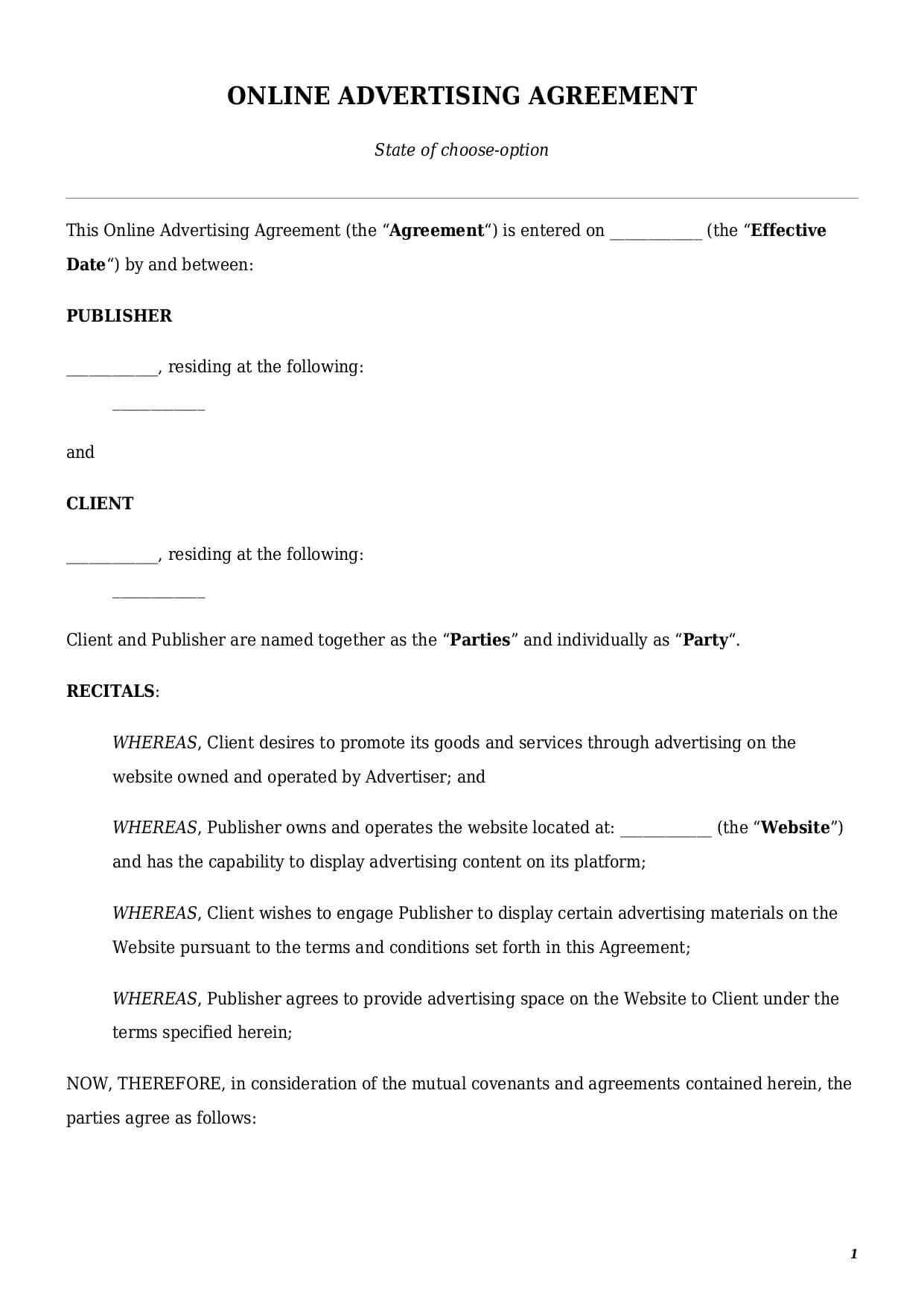Online Advertising Agreement
Reviews


What is online advertising agreement?
An online advertising agreement is a legal contract between two or more parties that sets out the terms under which advertising will be placed on a website. The document defines terms and conditions for cooperation between the parties, including:
- details of the parties involved;
- description of advertising content (limitations, requirements);
- timeline of advertising campaign;
- payment terms;
- IP clause;
- indemnification and liability clause.
The parties involved in a website advertising agreement template are the client and publisher. A client is an individual or business who wishes to promote their goods and services by placing ads on the website. The publisher is a website owner who owns a website and is ready to place the client’s advertising content on it.
How to draft an online advertising agreement template?
Drafting an online advertising agreement template from scratch might be a daunting task. We’ve got your back covered by making a detailed list of the most important elements a solid advertising agreement should have.
Requirements for Ad Content
The thing No. 1 any website advertising agreement should have is a detailed description of ad content. It is not only about what is inside the content but also about its size, quality, etc.
- Content Requirements: The Text of a website advertising agreement usually lays out the list of topics that cannot be included in ads (e.g., politics, tobacco products, drugs, etc.).
- Exclusivity: Parties also have to define if the client’s ads shall be exclusive advertising content on the website or if ads of third parties are also allowed. In most cases clients have to be sure that ads of their competitors are not being published along with their own ads on the same page or within the same post or video.
- Technical characteristic: In the case of website advertising, the text of a document should define the type of ad (e.g., banner, side-up, etc.) and the website’s URL. In the case of video advertising, the contract shall address if it should be a pre-roll, mid-roll, or post-roll video ad. Finally, for native advertising agreements, clients may wish to indicate the minimum number of times the name of their product or company is mentioned in a post or article. Besides that, the final contract shall define the dimension of the ad, its demographic target, and even the language.
- Approval process: Even if advertising content meets all the requirements stipulated by the advertising agreement, it should be first approved by the publisher. Therefore, a client has to send their advertising content within a certain period of time before the agreed date.
Details of Advertising Campaign
Every online advertising agreement sample provides the exact duration of the online campaign. Therefore, parties have to indicate its exact start and end date.
Usually the contract automatically ends upon the termination of the advertising campaign. However, parties may include an automatic prolongation clause. It means that the contract will automatically prolong after its end date on the same terms and conditions, unless either party sends a prior written notice to end it.
Payment Terms
Another crucial element for every advertising agreement contract is its payment terms. There are a number of considerations parties have to agree on in advance:
- Pricing model: The most common pricing model for online advertising agreements is click-per-rate or click-per-impression. In the first scenario a client pays a publisher for every click on their ad. In another case a client pays for every video or impression an ad made. A less common pricing model is a fixed fee for all advertising campaigns.
- Payment terms: The text of the advertising agreement sample should also define when a client has to pay for the advertising campaign. If it is a fixed fee payment model, a publisher may ask for payment in full either at the beginning or at the end of a campaign. In the case of a CPC or CPM model, a client usually pays based on the issued invoice.
- Acceptable payment methods: Parties should also agree upon acceptable payment methods (e.g., bank transfer, cash, or Bitcoin).
Intellectual Property Rights
Parties in online advertising agreement contract should include a solid IP protection clause.
Since a publisher should have access to the client’s content, the text of the agreement shall provide the publisher with a free license to use this content or the client’s logo/brand for publication. In its return, such a right shall expire once the advertising campaign or agreement ends.
Limitation of Liability
Parties to an advertising agreement contract may need to consider the inclusion of a detailed liability clause. In particular, we usually recommended to limit a liability cap to avoid excessive compensations once the triggering event occurs.
It is common for this type of an agreement to limit either party’s liability by the total price of the advertising campaign. In other words, a party’s contractual liability shall be limited to the total amount paid by the client to the publisher within the duration of their cooperation.
How to customize an advertising agreement at Faster Draft?
To get a fully personalized agreement template, follow a few easy steps below:
- Click the button “Create Document.”
- Answer simple questions in the form.
- Select a document’s template—online advertising agreement PDF or Word.
- Make a payment.
- E-sign, download, print, and use a customized document template in minutes.
Table of content
Frequently Asked Questions (FAQ)
-
1. What is the difference between a social media influencer agreement and a website advertising agreement?
In a social media influencer contract, a client pays for promotion of their goods or services through social media channels like Instagram, TikTok, etc. Under this type of agreement an influencer publishes an ad about a client’s products or services on their account.
A client in a website advertising agreement pays a website’s owner for ad publication on the website.
While both documents deal with online advertising in general, they feature different platforms for posting ads.
-
2. What is the difference between an affiliation agreement and an advertising agreement?
At first look documents appear very similar, as they both deal with promoting and advertising goods and services to the public. However, those documents represent different ways of featuring advertising content online.
Under an online advertising agreement, the client’s advertising content is displayed on a specific digital platform or website. The client pays the publisher for making the content discoverable to users on that particular site.
By virtue of an affiliation agreement, things are opposite. A publisher promotes the client’s products or services through various channels such as Facebook, Instagram, or their own website. The client, in turn, provides the publisher with a unique link that can be placed on the publisher’s site or social media to direct users to the client’s offerings.

Looking for something Different?
Start typing to find out our collection of legal documents and contract templates
